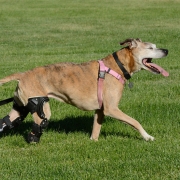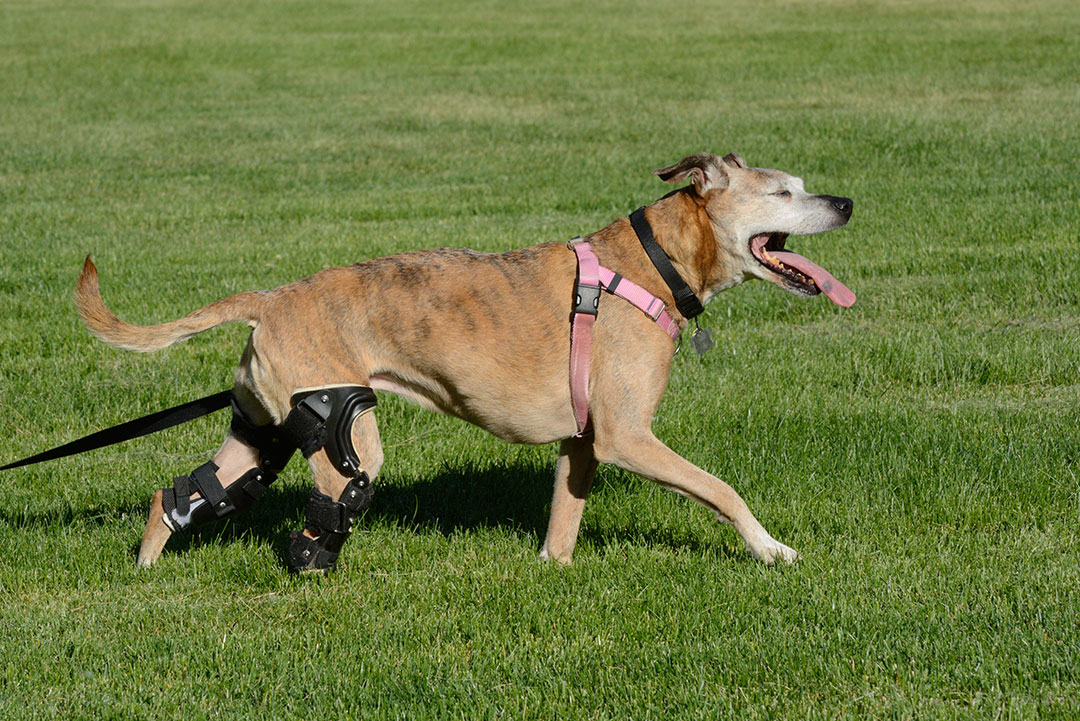Determining Factors: When Is Surgery Needed for a Cruciate Tear in a Dog?
In dogs, cranial cruciate ligament disease (CrCLD) is a chronic disease marked by the degradation of the cruciate ligament, one of the primary ligaments that supports a dog’s stifle joint (knee). The disease eventually leads to the rupture of the cruciate ligament, which is similar to a person tearing his or her ACL (anterior cruciate ligament).
Causes of CrCLD
Cranial cruciate ligament disease has a genetic predilection and is common to certain breeds, but other issues like excessive weight can exacerbate the problem. 50% of dogs that have a ligament tear in one leg will tear the ligament of the other stifle joint within six to twelve months.
Clinical Signs of CrCLD
Although a chronic disease, the onset of symptoms (primarily lameness) is usually acute. A dog will suddenly hold up his or her leg. This lameness tends to appear worse with exercise and better with rest.
CrCLD Diagnosis
To diagnose CrCLD, a veterinarian will perform a physical examination of a dog’s joint, which will reveal excessive forward movement of the tibia (called a cranial drawer). X-rays will also be taken to rule out other concerns. X-rays won’t reveal the ruptured ligament, but can show secondary changes, such as osteoarthritis or fluid within the stifle.
Dog Knee Surgery: Treatments for a Cruciate Tear in a Dog
Tibial Plateau Leveling Osteotomy (TPLO)
Most pets require surgical repair following a cruciate rupture. Different techniques are available including lateral fabellar, tibial plateau-leveling osteotomy (TPLO), and tibial tuberosity advancement (TTA) surgeries. Regardless of the surgical technique, exercise restriction and rehabilitation with dog physical therapy will be essential to the ultimate success of the pet’s surgery. Given the proper recovery care, most pets are able to return to normal function.
Factors that Determine if Surgery Is Needed for a Canine Cruciate Tear
Surgery following a cruciate tear is usually the only treatment that enables a pet’s full recovery. There are, however, certain cases when surgery might not be recommended. A veterinarian will consider a long list of factors before recommending a dog for a TPLO procedure or another surgical repair.
Genetics
For certain breeds (including golden retriever, Rottweiler, Neapolitan mastiff, Newfoundland, Akita, St. Bernard, American Staffordshire terrier, and mastiff), surgery is often inevitable. Larger breeds’ increased weight makes a non-surgical recovery less likely. Also, due to their genetic tendency, 50% of these dogs will tear the ligament of the other knee within six to twelve months. In these cases, attempting to manage CrCLD without surgery can wind up putting more pressure and strain on the other limb, which accelerates the second rupture and leads to the tear of both ligaments.
Full vs. Partial Tear
Sometimes a dog’s cruciate tear might be only partial. This can be difficult to determine in pets since they’re not undergoing MRI exams as people would. In veterinary medicine, the diagnosis of a full or partial tear can be made by arthroscopy of the stifle but is more frequently estimated based on the palpation of the cranial drawer and clinical signs.
Meniscal Tear
A piece of cartilage, the meniscus acts as a cushion in the stifle joint. The meniscus can tear at the time of a cruciate rupture or after. Often, it will catch during certain movements, causing additional pain. Patients with meniscal tears seldom regain full use of their legs without surgical correction.
Size and Excessive Weight
Unfortunately, dogs can’t tell us how they feel following surgery. As a result, deciding which procedure is better for a dog must be based on the observational outcomes of both surgical procedures.
Short-Term Considerations
If large or overweight, a pet’s size can contribute to excessive strain on the joint. “One of the biggest factors I have seen in determining if rehabilitation alone, without surgery, will be successful is the size of the patient,” says Dr. Jessica Pizzillo, DVM, CCRP. “Very few patients over 35 pounds have desirable outcomes without surgery.”
In addition, trying to help a dog lose weight while recovering from a cruciate rupture is challenging because part of the recovery involves exercise restriction. With surgery, we can fix the dog’s cruciate ligament, work through the normal recovery, and then begin an appropriate diet and exercise program for weight loss.
Age and Underlying Medical Conditions
Younger dogs with a tear are more likely to develop arthritis over time. As a result, it’s beneficial to fix and avoid future concerns. On the other hand, there are concerns with older dogs undergoing general anesthesia, which a veterinary must conservatively manage. In addition to age factors, underlying medical conditions such as Cushing’s disease or hypothyroidism can predispose a pet to ligament rupture, but can also complicate strategies for surgery and anesthesia.
Clinical Signs
The most important factor in determining whether surgery is recommended is your pet’s overall condition and the severity of clinical signs and symptoms. “The number one factor that influences surgery is how well the pet is doing,” says Dr. Mark Beerenstrauch, DVM. “If we are trying to avoid a surgery, but a pet is still experiencing pain and discomfort, then we will move from a more conservative approach to a surgical correction.”
Although some pets with a cruciate tear can be managed with exercise restriction, pain medication like anti-inflammatories, and canine rehabilitation (dog physical therapy) and live a normal, active life, it’s the opinion of Dr. Bilicki, DVM, DACVS-SA, Diplomate ACVS, that surgery is the best way to go.
“Surgery is the fastest and most complete way to achieve full function with added benefits. Surgery alleviates inflammation, which causes direct damage to cartilage, and surgery allows the patient to work toward stopping the cycle of disuse and muscle atrophy to start building muscle mass, strength, and endurance as quickly as possible,” Dr. Bilicki says. “In my opinion, the moment we determine a patient has the cruciate disease — whether it is a partial, full, or chronic rupture — surgery is indicated.”
If your dog suffers a cruciate tear, our team of veterinary professionals will work with you to determine the best course of treatment based on your pet’s individual health and medical concerns.




